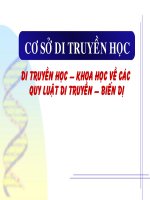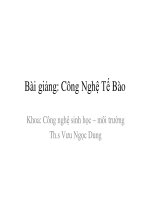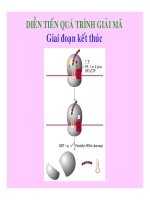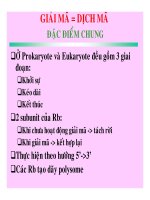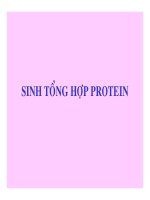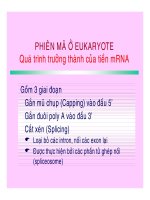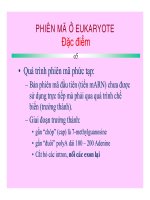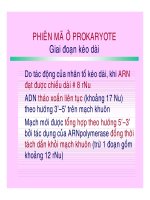Slide bài giảng: Cơ sở di truyền học ở mức phân tử: Acid Nucleic và Protein.
Bạn đang xem bản rút gọn của tài liệu. Xem và tải ngay bản đầy đủ của tài liệu tại đây (2.33 MB, 53 trang )
Cơ sở di truyền học cơ
bản ở mức phân tử
Basic Molecular Genetic Mechanisms
Gmail:
Facebook: />
Outline DNA nucleotide structure in terms of sugar
(deoxyribose), base and phosphate
• DNA (Deoxyribonucleic acid) is made up of nucleotides, which contain
3 parts: A phosphate group, a deoxyribose sugar, and a nitrogenous
base.
• There are four different kinds of nitrogenous bases: Adenine (A),
guanine (G), cytosine (C), and thymine (T).
Outline DNA nucleotide structure in terms of sugar
(deoxyribose), base and phosphate
• In both types of nucleic acids, the
nucleotides contain a 5-carbon
sugar.
DNA Deoxyribose Sugar
RNA Ribose Sugar
• In a nucleotide, the nitrogenous
base is connected to the first
carbon and the phosphate group is
connected to the fifth carbon.
Outline DNA nucleotide structure in terms of sugar
(deoxyribose), base and phosphate
• Covalent bonds connect the 5’ and 3’
ends of each nucleotide.
• Phosphodiester bonds link each sugar
with a phosphate group in between.
• Creates a sugar-phosphate backbone.
• Alternates between sugar and
phosphate groups.
Explain how a DNA double helix is formed using
complementary base pairing and hydrogen bonds.
• In DNA, Adenine always bonds to Thymine
and Guanine always bonds to Cytosine.
Why is this?
What type of bond is formed ?
What is the benefit to this type of bond ?
A purine always bonds to a pyrimidine
Maintains a constant width in the DNA molecule.
Nucleotides = Base + Sugar + Phosphate
Nucleosides = Base + Sugar
Describe the structure of DNA, including the antiparallel strands, 3’–5’
linkages and hydrogen bonding between purines and pyrimidines
B
Describe the structure of DNA, including the antiparallel strands, 3’–5’
linkages and hydrogen bonding between purines and pyrimidines
• Antiparallel Stands of DNA:
Direction of strand is determined by the
sugar–phosphate bonds.
Phosphate groups connect to the 3′ C of one
sugar, and the 5′ C of the next sugar.
At one end of the chain—a free 5′ phosphate
group; at the other end a free 3′ hydroxyl.
Compare the structure of RNA and
DNA
• Shape:
DNA - Double-Stranded
RNA - Single-stranded
• Sugar:
DNA - Deoxyribose
Ribose - Ribose
• Bases:
DNA - Thymine
RNA - Uracil
• Location
DNA - Nucleus
RNA - Leaves the nucleus
Protein structure
An a-helix and sheet of Protein
Bonds group in a molecular protein
Multiple choice questions
• Formula group in molecular biology
About DNA:
trong các DNA là khác nhau và đặc trưng bởi từng loài.
Hydrogen bonds:
+ Đánh giá tính bền nhiệt của các phân tử DNA.
+ Đảm bảo cấu trúc bền vừng của DNA nhưng cũng dễ dàng tách 2 mạch DNA.
Mỗi vòng xoắn của chuỗi xoắn kép DNA dài 34 và gồm 10bp . Vậy mỗi bp ứng với 3,4 .
Đổi đơn vị : 1 micromet (μm) = 104 A0
1 micromet = 106 nanomet (nm)
1 mm = 103 μm = 106 nm = 107 A0
Multiple choice questions
•• Formula group in molecular biology
About DNA:
.
H = 2A + 3G = 2T + 3X.
.
.
M = N.300.
LKCHT / 1 mạch đơn = .
LKCHT / 2 mạch = N – 2.
Tổng LKCHT trong phân tử DNA = 2N – 2.
B
Multiple choice questions
• Xét một phân tử DNA
A1 = T2 , T1 = A2 , G1 = X2 , X1 = G2.
Số nucleotit từng loại của DNA:
A = T = A1 + A2 = T1 + T2 = A1 + T1 = A2+ T2.
G = X = G1 + G2 = X1 + X2 = G1 + X1 = G2 + X2.
Thành phần phần trăm từng loại nu của DNA:
(%A1 + %A2 )/2= (%T1 + %T2 )/2= %A = %T
(%G1 + %G2 )/2=( %X1 + % X2 )/2= %G = %X
Virut, DNA chỉ có 1 mạch.
Ở tinh trùng và trứng, hàm lượng DNA giảm 1/2 hàm lượng DNA trong tế bào sinh dưỡng.
Ở kỳ đầu, kỳ giữa, kỳ sau: hàm lượng DNA gấp 2 hàm lượng DNA ở các giai đoạn khác.

